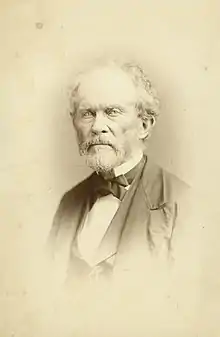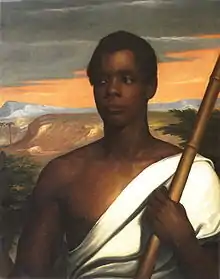Nathaniel Jocelyn
Nathaniel Jocelyn (January 31, 1796 – January 13, 1881) [1] was an American painter and engraver best known for his portraits of abolitionists and of the slave revolt leader Joseph Cinqué.
Nathaniel Jocelyn | |
|---|---|
 Nathaniel Jocelyn, c.1870s, albumen print (cabinet card), National Gallery of Art, Washington, DC, Department of Image Collections. | |
| Born | January 31, 1796 |
| Died | January 13, 1881, aged 84 |
| Nationality | American |
| Occupation | portrait painter, printmaker |
Family and education
Nathaniel Jocelyn was born in New Haven, Connecticut, the son of clockmaker and engraver Simeon Jocelin and Luceanah Smith.[2] He trained under his father as a watchmaker, later taking up drawing, engraving, and oil painting.[1] He studied engraving with George Munger around 1813; they published at least one print together under the name Jocelin & Munger. In 1817, Munger painted one of the few known portraits of Jocelyn.[2]
The inventor Eli Whitney also helped to foster his career, and in 1820 he briefly worked in the studio of Samuel F. B. Morse.[1] Later, in 1829–30, he furthered his education by touring Europe with Morse and the architect Ithiel Town.[1]
During the War of 1812, at the age of 16, he volunteered for the Governor's Foot Guard, which defended the city of Madison, Connecticut.[2]
In 1818, he married Sarah Atwater Plant of New Haven.[3] They had six daughters and a son, Isaac, who died at the age of six.[2]
Career

In 1817, Jocelyn moved to Hartford, Connecticut, where helped set up the Hartford Graphic and Bank Note Engraving Company.[3] From 1820 to 1822 he lived in Savannah, Georgia, where he established himself as a painter of portraits and miniatures.[2] On returning to New Haven in 1822, he continued as a portraitist. He was an abolitionist, and among his sitters were several notable abolitionists, including William Lloyd Garrison. Garrison declared that Jocelyn's portrait was a "tolerable likeness," but remarked that "those who imagine that I am a monster, on seeing it will... deny its accuracy, seeing no horns about the head."[4]
Another of Jocelyn's well-known works is his 1839 portrait of Joseph Cinqué, leader of a revolt on the Spanish slave ship La Amistad.[2] Jocelyn and his brother Simeon were also active in seeking legal counsel for Cinqué's defense.[2]
In 1827 he was elected an Associate of the National Academy of Design, and he became a full Academician in 1846. Throughout his career, he often showed work at the academy's annual exhibitions.[3]
Jocelyn continued as an engraver alongside his portrait business. In the 1830s, he and his brother Simeon Smith Jocelyn founded and ran an engraving company under the name N. & S. S. Jocelyn.[3]
From 1843 to 1847, Jocelyn had a second portrait studio in New York City. His New Haven studio burned in 1849, and for a time he gave up painting for engraving, initially with the firm of Toppan, Carpenter & Co. He went on to found the National Bank Note Engraving Company, where he served as head of the art department through to the end of the Civil War.[3]
After the war, he returned to painting, working out of a studio provided for him at the recently founded Yale School of Art, where he served as curator of Italian art.[1] He retired in 1864 and died in New Haven.[3]
Legacy
In 1858, Jocely and his brother gave a piece of land to the city of New Haven to be used as public park and playground. It is now known as Jocelyn Square.[2]
Many of Jocelyn's portraits are in the collection of Yale University.[5]
References
- Marter, Joan M., ed. Grove Encyclopedia of American Art, vol. 1, p. 638.
- "Clarissa Munger Badger". Madison Historical Society website.
- "Nathaniel Jocelyn 1796-1881". National Academy Museum website.
- "William Lloyd Garrison". "Slavery and Abolition", CivilWar@Smithsonian, Smithsonian Institution website.
- "Nathaniel Jocelyn" (search results). Yale University Art Gallery website.